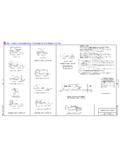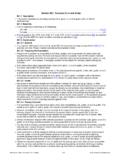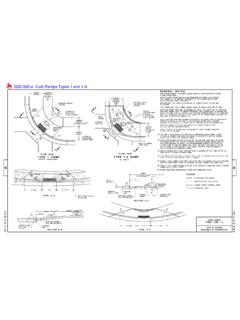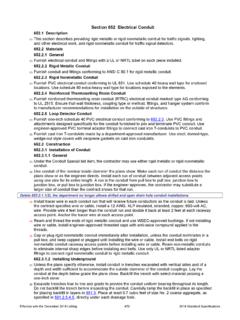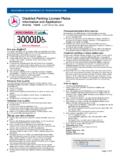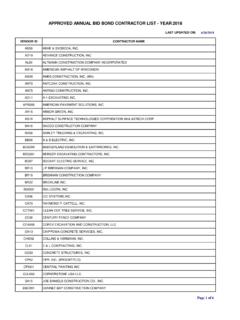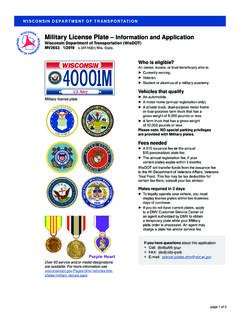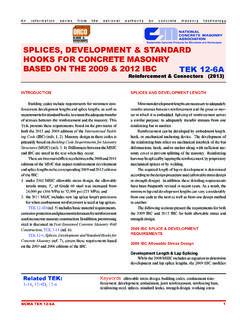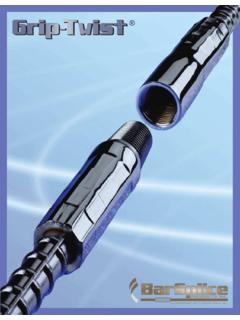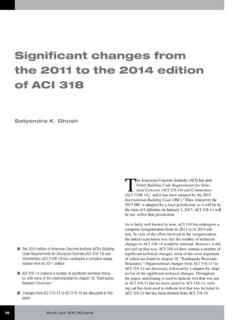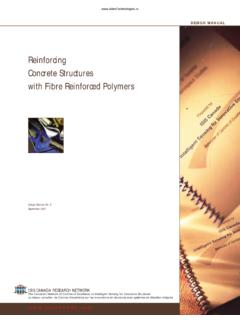Transcription of Chapter 9 Materials - wisconsindot.gov
1 WisDOT Bridge Manual Chapter 9 Materials July 2018 9-1 Table of Contents General .. 2 Concrete .. 3 Reinforcement Bars .. 4 Development Length and Lap Splices for Deformed Bars .. 5 Bends and Hooks for Deformed Bars .. 6 Bill of Bars .. 7 Bar Series .. 7 9 Miscellaneous Metals .. 11 Timber .. 12 Miscellaneous Materials .. 13 Painting .. 15 Bar Tables and Figures .. 17 Granular Materials .. 25 References .. 26 Appendix - Draft Bar Tables .. 27 WisDOT Bridge Manual Chapter 9 Materials July 2018 9-2 General The Wisconsin Standard Specifications for Highway and Structure Construction (hereafter referred to as Standard Specifications) contains references to ASTM Specifications or AASHTO Material Specifications which provide required properties and testing standards for Materials used in highway structures.
2 The service life of a structure is dependent upon the quality of the Materials used in its construction as well as the method of construction. This Chapter highlights applications of Materials for highway structures and their properties. In cases where proprietary products are experimentally specified, special provisions are written which provide material properties and installation procedures. Manufacturer s recommendations for Materials , preparation and their assistance during installation may also be specified.
3 Materials that are proposed for incorporation into highway structure projects performed under the jurisdiction of the Wisconsin Department of Transportation (WisDOT) may be approved or accepted by a variety of procedures: Laboratory testing of Materials that are submitted or samples randomly selected. Inspection and/or testing at the source of fabrication or manufacture. Inspection and/or testing in the field by WisDOT regional personnel. Manufacturer s certificate of compliance and/or manufacturer s certified report of test or analysis, either as sole documentation for acceptance or as supplemental documentation.
4 Inspection, evaluation and testing in the normal course of project administration of material specifications. Some products are on approved lists or from fabricators, manufacturers, and certified sources approved by WisDOT. Lists of approved suppliers, products, and certified sources are located at: The Wisconsin Construction and Materials Manual (CMM) contains a description of procedures for material testing and acceptance requirements in Chapter 8, Section 45. Materials , unless otherwise permitted by the specifications, cannot be incorporated in the project until tested and approved by the proper authority.
5 WisDOT Bridge Manual Chapter 9 Materials July 2018 9-3 Concrete Concrete is used in many highway structures throughout Wisconsin. Some structure types are composed entirely of concrete, while others have concrete members. Different concrete compressive strengths (f c) are used in design and depend on the structure type or the location of the member. Compressive strengths are verified by cylinder tests done on concrete samples taken in the field. The Standard Specifications describe the requirements for concrete in Section 501.
6 Some of the concrete structure types/members and their design strengths for new projects are: Decks, Diaphragms, Overlays, Curbs, Parapets, Medians, Sidewalks and Concrete Slab Bridges (f c = 4 ksi) Other cast-in-place structures such as Culverts, Cantilever Retaining Walls and Substructure units (f c = ksi) Other types of Retaining Walls (f c - values as specified in Chapter 14) Prestressed I Girders (f c = 6 to 8 ksi) Prestressed Box Girders (f c = 5 ksi) Prestressed Deck Panels (f c = 6 ksi) Grade E concrete (Low Slump Concrete)
7 Is used in overlays for decks and slabs as stated in Section The modulus of elasticity of concrete, Ec, is a function of the unit weight of concrete and its compressive strength LRFD [ ]. For a unit weight of kcf, the modulus of elasticity is: f c = ksi ; Ec = 3600 ksi f c = 4 ksi ; Ec = 3800 ksi For prestressed concrete members, the value for Ec is based on studies in the field and is calculated as shown in The modulus of rupture for concrete, fr, is a function of concrete strength and concrete density, and is described in LRFD [ ].
8 The coefficient of thermal expansion for normal weight concrete is 6 x 10-6 in/in/ F per LRFD [ ]. Air entraining admixture is added to concrete to provide durability for exposure to freeze and thaw conditions. Other concrete admixtures used are set retarding and water reducing admixtures. These are covered in Section 501 of the Standard Specifications. WisDOT Bridge Manual Chapter 9 Materials July 2018 9-4 Reinforcement Bars Notice: Section contents and the LRFD [article numbers] referenced in this Section are based on AASHTO LRFD Bridge Design Specifications (7th Edition 2014).
9 Reinforced concrete structures and concrete members are designed using Grade 60 deformed bar steel with a minimum yield strength of 60 ksi. The modulus of elasticity, Es , for steel reinforcing is 29,000 ksi. Reinforcement may be epoxy coated and this is determined by its location in the structure as described below. Adequate concrete cover and epoxy coating of reinforcement contribute to the durability of the reinforced concrete structure. The Standard Specifications describe the requirements for steel reinforcement and epoxy coating in Section 505.
10 Epoxy coated bars shall be used for both top and bottom reinforcement on all new decks, deck replacements, concrete slab superstructures, structural approach slabs and top slab of culverts (with no fill on top). They shall be used in other superstructure elements such as curbs, parapets, medians, sidewalks, diaphragms and pilasters. Some of the bars in prestressed girders are epoxy coated and are specified in the Chapter 19 - standards . Also use coated bars for sign bridge footings. Use epoxy coated bar steel on all piers detailed with expansion joints and on all piers at grade separations.
